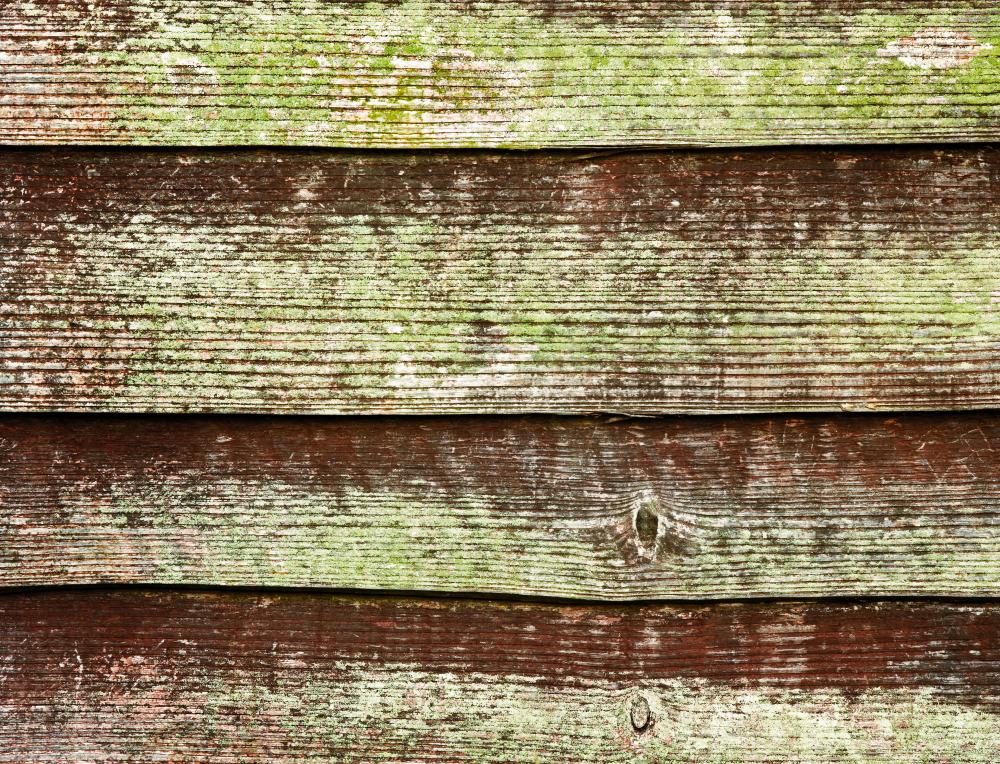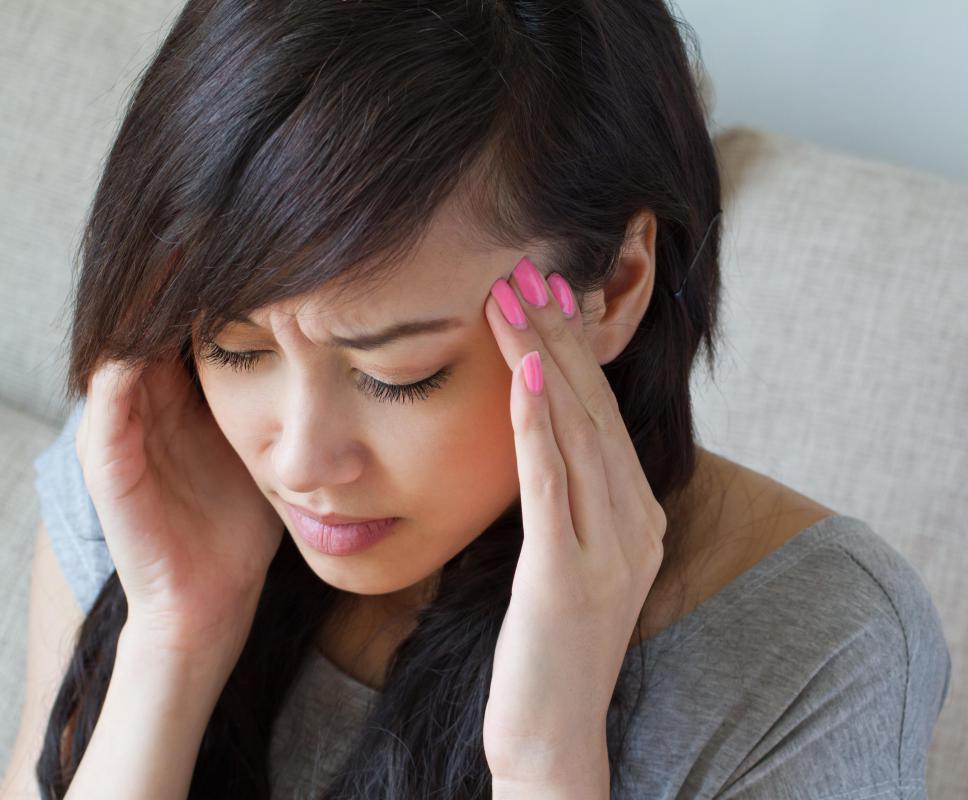At HomeQuestionsAnswered, we're committed to delivering accurate, trustworthy information. Our expert-authored content is rigorously fact-checked and sourced from credible authorities. Discover how we uphold the highest standards in providing you with reliable knowledge.
What is Yellow Mold?
Yellow mold is a fungus that normally grows in dark and damp places. Several species of this mold exist, with some belonging in genera that are toxic or widely known to destroy wood. It is usually obvious when a building has a yellow mold infestation because the mold's color is often bright and difficult to miss. The color of this type of mold does vary, however; for example, some can appear almost white, and many are at least tinged with white. Correctly identifying the mold as a certain species is difficult and best left to a professional who can test it in a lab.
One type of yellow mold is toxic and generally belongs to the Aspergillus genus, in which several hundred other species of mold are categorized. Some of these molds, including the toxic yellow variety, can be dangerous to both humans and animals. If yellowish mold is found in a building, it should be treated with caution, and should not be touched without gloves or breathed in. Rampant yellow mold with white fruit bodies growing from it is a sign that the affected area has been very damp for a long time. Ridding the building of this mold usually involves treating any leaks and drying up moisture, or else it is likely the mold will come back.

Another mold that appears yellow is the species Serpula lacrymans, which is widely known as the house-eating mold because it is a fungus frequently responsible for dry rot. This mold tends to be dark yellow, almost gold in color, with white spores growing from it when conditions are right. As with most molds, warmth and moisture are ideal for the growth of dry rot. This type of mold was first documented in the early 1700s and has since aided or caused the deterioration of a vast number of wood buildings. Wood furniture, whether indoors or out, is also vulnerable to developing mold and will eventually be destroyed if not treated.

Providing good ventilation, limiting moisture, and keeping surrounding areas clean can help prevent the growth of yellow mold. Mold cannot thrive without moisture, so ventilating an area well and taking care of leaks quickly is usually a good defensive strategy. Regular cleaning of the area can also prevent the growth of yellow mold, as well as kill invisible spores. Soap and warm water, diluted bleach, or certain commercial cleaning products are routinely used for these purposes.
AS FEATURED ON:
AS FEATURED ON:















Discussion Comments
No, I do not believe any of this information. The 'yellow mold' this article is discussing are actually lichens! Not harmful to anyone, but they are actually indicators of clean air. Many studies have used lichens as biomonitors for air pollution.
I read an article that stated after years of illness, a urine test was used to diagnose mold poisoning in a woman.
How does yellow mold affect one's health?
I had no idea that yellow mold could be so dangerous! I feel like I always hear about black mold health risks on the news and stuff, but never about yellow mold or any other kind. But that's really scary.
Luckily I don't have a mold problem in my apartment right now, but from now on I'm going to be very vigilant about cleaning up and moisture in the bathroom and other areas. Toxic yellow mold is not a problem I'm interested in dealing with!
@dautsun - Dehumidifiers are great for preventing mold and accompanying mold symptoms. My parents had a slight mold problem in their basement, so they installed a dehumidifier after they cleaned it up. They haven't had any more mold growth since then!
Mold is really scary though, especially if you live in an apartment and don't have total control over the space. A good friend of mine actually had to move recently, because she had a really bad mold problem in her bathroom because the apartment above her was leaky. Her landlord wouldn't do anything about it, so she moved to preserve her health!
As the article said, keeping your house free of moisture and standing water is the best way to prevent mold in homes. Basically, there are mold spores in the air all the time, everywhere. However, they need moisture to grow. So if there is no moisture, they won't have a place to grow. But if there is, then you're going to have a problem on your hands!
If you live in a humid area, you might consider investing in a dehumidifier for your home. These handy little machines suck moisture out of the air and decrease the potential for mold growth.
@ddljohn-- If it's a small area, just clean it up yourself with some dish detergent. But wear gloves and a mask, don't breathe any of it while you are cleaning it up.
Also, if you have difficulty breathing, or if you get a headache or allergic reactions, you might have inhaled the mold. Go to the hospital if you have any of those symptoms of mold exposure.
We used to have a huge yellow mold problem in our garage. It was way too big for us to clean it up without being exposed to it so we let the experts handle it. We shelled out a lot of money for the cleanup, but had no other choice.
@ddljohn-- There are mold tests and air tests that you can do yourself to find out if the mold is toxic or not. I think the air tests that count the amount of fungi spores in the air are really expensive. And it won't be of any use to you since yours is outside. But the surface test might help you determine if it's toxic.
By the way, how large is the yellow mold? The bigger the mold gets, the more dangerous it is.
The faster you get rid of it, the better it will be for you. If you allow it to keep spreading and if it is a toxic type of yellow mold, it can be a health hazard for those who are around the mold for a long time. It's not a risk you want to take if you have kids and pets.
There are mold removal specialists who can get rid of it for you. I'm sure you can find one in your area.
I think I have yellow mold growing right outside of my house on the wall. It's mostly white with some yellow spots and seems to be flowering little white fruits or flowers. I have no idea where to get it tested to know which kind of yellow mold it is. So I haven't done anything about it and have just left it alone for the past few weeks.
The weather has been very humid this year and I'm pretty sure that this is why the mold has come about. I don't know how I can keep it dry considering that it's outside. The bad thing is that it's growing in the corner of the wall that doesn't get any sunlight.
Has anyone had a yellow mold problem in or around their house before? How did you get rid of it?
Do you think we're at risk from it?
Post your comments